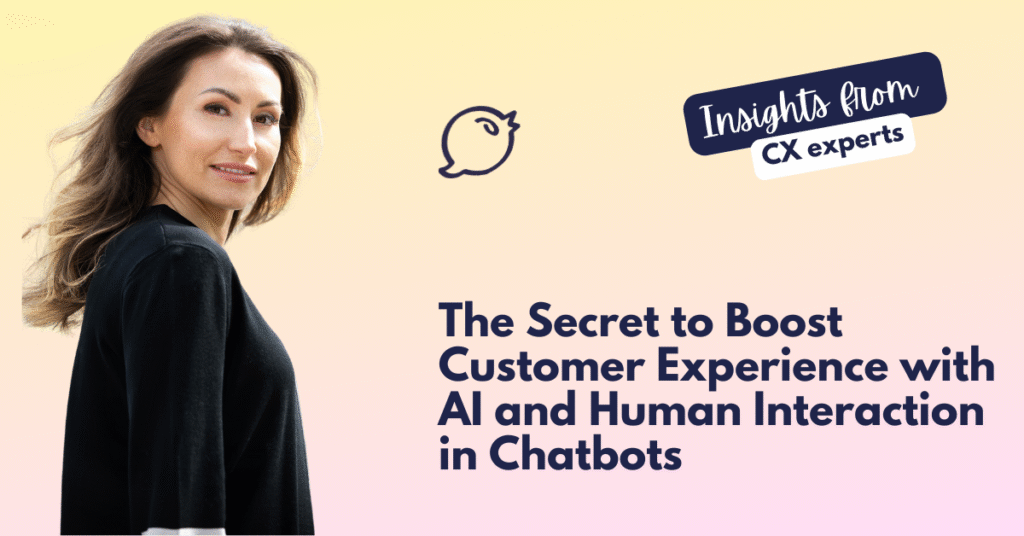The Secret to Boost Customer Experience with AI and Human Interaction in Chatbots

Sandra Roosna
Askly CEO & Founder

Picture this: You’re having a small or big issue or one question about your order. By the time you finally speak to a human agent, your patience is gone, and your mood isn’t great.
We’ve all been there.
Now imagine instead, you type a quick message on a website and within seconds, a new-gen chatbot not only answers your question but also does exactly what you wanted.
That little shift is why new-gen AI chatbots are quietly rewriting the rules of customer service.
People don’t want to talk to “just” machines.
We need empathy, humor, and that human reassurance that we will get help.
The magic happens when businesses combine AI’s efficiency with the warmth of human interaction. Let’s unpack how to achieve that balance and shape customer experience.
The Rise of New-Gen Chatbots
Five years ago, chatbots were clunky. They misunderstood simple requests (“No, I didn’t mean Paris, Texas, I meant Paris, France”). Fast forward to now, and things are very different.
If you get real help quickly, it was probably very human-like AI Assistant or new-gen chatbot.
Thanks to natural language processing (NLP) and machine learning, chatbots can understand context, tone, even intent.
Statista recently highlighted that businesses using AI-driven chatbots saw a 20–30% increase in customer engagement since 2023.
Because these bots aren’t just answering questions. They’re offering personalized recommendations, tracking customer preferences, and creating smooth shopping journeys. Exactly as humans would do.
SMEs win the most from New-Gen AI
For small businesses especially, this is huge opportunity. We have worked with 1000+ SMEs, both e-commerce businesses and service providers.
A single chatbot can do the work of an entire frontline support team, freeing up human agents to focus on what really needs empathy and creativity. It means SMEs can not only survive in tight competition against large corps, but grow loyalty and recurring revenue with CX, that makes customers return.
Large corps use AI widely
Take Marriott Hotels. Their digital concierge doesn’t just confirm your booking.
It helps with room service, gives you local tips, and even handles late check-outs. Guests leave happier, and Marriott saves countless hours of staff time.
Or look at Sephora.
Their chatbot isn’t a cold Q&A machine, it suggests personalized skincare routines, helps you virtually “try on” makeup, and guides you to the right products.
The result? More sales, fewer returns, and customers who feel genuinely looked after.
These aren’t futuristic “what ifs”—they’re happening right now.
Why Balance Still Matters
AI chatbots are powerful, but nobody wants to explain a complicated billing error to a bot that keeps looping back with the same canned response.
This is where humans step in. The smartest businesses use a hybrid model. No team members shall ever again reply 45 or 126 times the same question.
Chatbots can and must handle FAQs and quick wins, while human agents jump in for complex or sensitive cases.
When looking for the right tool, it needs to have a decision making engine for seamless transitions between AI and human-powered teams.
One such tool is Askly, where the complex cases are assigned to humans before customers get frustrated.
In fact, modern bots are trained to “know when they don’t know.”
They can hand off a conversation to a human without making the customer repeat themselves. That smooth handover makes all the difference between frustration and delight.
The Challenges We Can’t Ignore
Data security is one of the biggest concerns.
Customers want quick service, but not at the cost of their personal information. Businesses need to build trust by keeping chatbot interactions secure and transparent.
And then there’s the ethical side. If a chatbot is trained on biased data, it can unknowingly treat customers unfairly. That’s why constant monitoring and updates are just as important as flashy new features.
We never recommend using free chatbot tools or live chat plugins for the safety of your data.
What’s Next for Chatbots?
Things get exciting. Firstly, already now, we cannot make a difference between AI-powered chatbot and human reply, if it is setup professionally.
Such full-service high-quality chatbot solutions start from 300-500 eur/month.
Future chatbots are moving beyond reactive service into predictive service. Imagine your flight is delayed, and before you even reach out, the airline’s chatbot has already rebooked you on the next flight and sent you a meal voucher. That’s where we’re headed. You just provide your chatbot the process and framework once, what it can do and what it cannot.
Anticipating needs, not just responding to them.
And emotional AI is on the horizon too. Bots that don’t just respond to words, but detect tone and emotion. Offering empathy when you sound stressed or cheer when you sound excited. It sounds sci-fi, but it’s closer than most people realize.
Final Thoughts
Customer service is no longer about choosing between robots or humans.
It’s about blending the best of both.
Chatbots deliver speed, scale, and availability. Humans bring complex problem-solving finesse. Together, they create the kind of customer experiences that keep people coming back.
At Askly, we’ve seen firsthand how the right tools — especially in customer support — can make the difference.
From small businesses to global brands, the future belongs to those who embrace AI with a human touch.
We have worked with 1000+ service providers and e-stores, big and small, and helped them grow sales and build trust.
Askly is a simple plugin with massive AI-powered opportunities for customer communication. For example, Askly AI Assistant replies to customers on your website, FB and IG DMs 24/7 in 30 languages. You can try it free (no obligations) here.
About the author

Sandra Roosna
Askly CEO & Founder
Sandra Roosna is the founder and CEO of Askly, a multilingual customer support platform for e-commerce. With a background in international business and experience from Y Combinator’s Startup School, she built Askly to help online stores improve customer communication across Europe.
Want more happy customers with a small team? Askly can easily help you achieve it.
Free trial. No obligations. Start growing you business tomorrow.
Recent posts
AI in customer service that finally works.
No costs. No obligations.
